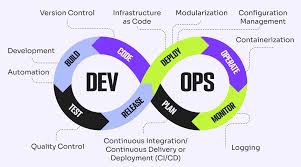info@gladsme.in
+91.8891968718
Mastering DevOps: Best Practices for Seamless Software Delivery
Mastering DevOps: Best Practices for Seamless Software Delivery

Welcome to our comprehensive guide on mastering DevOps practices! In today's fast-paced digital landscape, DevOps has become indispensable for organizations aiming to achieve faster delivery, improved quality, and enhanced collaboration across development and operations teams.
What is DevOps?
DevOps, a portmanteau of "development" and "operations," is a cultural and technical movement that emphasizes collaboration, automation, and integration between software development and IT operations. It aims to shorten the software development lifecycle, increase deployment frequency, and deliver high-quality software more rapidly.
Key DevOps Practices
Continuous Integration (CI):
CI involves frequently integrating code changes into a shared repository, followed by automated builds and tests. By integrating code early and often, teams can identify and address integration issues quickly, leading to fewer conflicts and faster delivery.
Continuous Delivery (CD):
CD extends CI by automatically deploying code changes to production or staging environments after passing through various stages of automated testing. It ensures that software can be released at any time with confidence, leading to shorter release cycles and reduced deployment risk.
Infrastructure as Code (IaC):
IaC involves managing and provisioning infrastructure through code and automation tools. By defining infrastructure as code, teams can version control, replicate, and automate the provisioning of infrastructure components, leading to more reliable and scalable environments.
Automation:
Automation is central to DevOps, enabling teams to streamline repetitive tasks, reduce manual errors, and accelerate the delivery process. Automation tools for provisioning, configuration management, testing, and deployment play a crucial role in achieving efficiency and consistency.
Monitoring and Logging:
Effective monitoring and logging provide visibility into system performance, application behavior, and infrastructure health. By monitoring key metrics and analyzing logs, teams can detect issues proactively, troubleshoot problems efficiently, and continuously optimize system performance.
Collaboration and Communication:
DevOps emphasizes fostering a culture of collaboration and communication across development, operations, and other stakeholders. Techniques such as cross-functional teams, shared responsibilities, and transparent communication channels promote alignment, trust, and shared accountability.
Implementing DevOps Practices
Assess Current State:
Begin by assessing your organization's current practices, processes, and tools related to development, deployment, and operations. Identify bottlenecks, pain points, and areas for improvement to prioritize DevOps initiatives effectively.
Define Goals and Metrics:
Set clear goals and measurable metrics aligned with business objectives to track the effectiveness of DevOps practices. Whether it's reducing time to market, increasing deployment frequency, or improving system reliability, establish quantifiable targets to guide your DevOps journey.
Build a Culture of Collaboration:
Cultivate a culture that values collaboration, experimentation, and continuous learning. Encourage cross-functional teams, foster open communication, and celebrate successes and failures as learning opportunities to drive cultural transformation and adoption of DevOps principles.
Select and Implement Tools:
Choose appropriate tools and technologies to support DevOps practices based on your organization's requirements, technology stack, and budget. From version control systems and CI/CD pipelines to monitoring and collaboration tools, invest in tools that streamline workflows and enable automation.
Automate Everything:
Embrace automation across the software delivery pipeline, from code integration and testing to deployment and monitoring. Automate repetitive tasks, standardize processes, and leverage infrastructure as code to achieve consistency, reliability, and scalability at scale.
Iterate and Improve Continuously:
DevOps is a journey of continuous improvement. Encourage experimentation, solicit feedback, and regularly review and refine your processes, tools, and practices. Embrace a mindset of iteration and adaptability to stay agile and responsive to changing business needs.
By adopting DevOps practices, organizations can unlock numerous benefits, including faster time to market, higher quality software, improved collaboration, and increased agility. However, successful DevOps implementation requires more than just adopting tools; it requires cultural transformation, collaboration, and a commitment to continuous improvement. Start small, iterate often, and embark on your journey to mastering DevOps for seamless software delivery.
Related Blogs

The Importance of Data Structures in Software Development
Read More...
Exploring Machine Learning Algorithms: A Beginner's Guide
Read More...
The Evolution of Programming Languages: From Assembly to Rust
Read More...
Understanding Big O Notation: A Guide for Developers
Read More...Subscribe for our Newsletter
Subscribe to elevate your software game! Stay updated on the latest trends, coding insights, and exclusive promotions with our newsletter.
